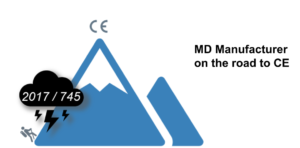Regulation (EU) 2017/745: guidance for Medical Devices manufacturers
Regulation (EU) 2017/745: guidance for Medical Devices manufacturers. The implementation timetable is dynamic, so do not hesitate to do a regulatory watch.
- Identify the medical device (MD) status of your products
In comparison to Directive 93/42 the scope of the regulation is broader, so more devices have to comply with its requirements:
- The definition of medical device has been completed (Article 2). Some nonmedical devices are now included (Annex XVI).
- The scope (included and excluded devices) is broadened (Article 1)
- The regulation is not only about MDs: accessories, dual-purpose devices, disinfection products. … are also concerned.
Action: verify the status of devices already on the market or under development.
- Determine the class of your medical devices
With the regulation the classification rules are changed, with a real tendency to harden: many devices will move from class I to IIa (see the medical-software) or even worse, from IIb to III (i.e., AIMDs and MDs consisting of a substance).
The rules are set out in Annex VIII chapter III. As with the directive: all rules are to be considered, the highest class prevails.
Action : define the class of your MDs according to the regulation.
- Choose a conformity evaluation procedure
The conformity evaluation procedures are modified, several choices are possible depending on the class and certain characteristics (sterile, implantable, custom…). The main road remaining a complete QMS (Quality Management System) + review of the TD (Technical Documentation).
Refer to article 52 to know the applicable annexes.
Action: choose a procedure, depending on the class of your MDs and your strategic decisions.
- Choose a Notified Body
The pressure is high on manufacturers, it’s worse for ON (refer on Annex VII).
The coming period is going to be complicated: more files to deal with, longer audits and fewer Notified Bodies (we are talking about -40%).
Also count with unannounced audits, at least 1 every 5 years (Annex IX.I.3.4), NBs already foresee them in their specifications. A dedicated procedure is desirable.
Action: verify that your NB is in the process of notification for the regulation, verify that your MDs will be in its scope of certification, plan the transition with the NB. Manufacturers moving from a class I to IIa will obviously need to find a NB willing to take them on.
- Upgrade your QMS
No big upheaval in QMS, the requirements are in section 10. 9, the ISO 13485:2016 is obviously applicable, it will be harmonized against the regulation. The changes in the 2016 revision are in line with the regulatory requirements (surveillance, incident management, device identifier, consideration of other actors…).
The bulk of the work will probably be in Post-Market Surveillance (and Clinical Follow-up) which will thicken your QMS.
Note the obligation to have a person in charge of regulatory aspects (article 15) with a well-defined profile (bachelor + 4 scientific/regulatory type + 1 year of experience or 4 years of exp).
A possibility is offered to companies with less than 50 employees (95% of MD companies) to subcontract this activity. Subcontracting a RAR (Regulatory Affairs Manager) can be dangerous, or unaffordable, it is better to take advantage of the transition period to make someone in-house (the quality manager, the head of the design office, the production…) become more competent.Action: appoint a regulatory manager, update the QMS, create the new procedures.
- Upgrade your Technical Documentation
Same philosophy as with 93/42: the Technical Documentation (Annex II) contains the response elements for the general safety and performance requirements (Annex I, “General safety and performance requirements”).
The responses to new requirements such as the UDI (Annex VI) or the documentation related to the PMS (Annex III) will be added to it.
The clinical evaluation is also to be reviewed, with sometimes big impacts (evaluation for class III as per Annex IX.II.5 .1) and the obligation to contractually access the manufacturer’s TD if a equivalent MD is used (article 61.5).Action: new frame of response to requirements, update of the TD, labelling, instructions for use… if applicable : update the clinical evaluation
- Work on Post-Marketing Surveillance (PMS)
This is where the regulation changes a lot, two parts:
1. The PMS (Post-Marketing Surveillance), Chapter VII: to be planned, summarized in a report and PSUR.
2. the PMCF (Post-Marketing Clinical Follow-up, Annex XIV. B): always a plan and report as well as a process evaluation report.Action: build procedures and define responsibilities.
- Register on Eudamed
Eudamed is based on a great idea: use the internet.
Manufacturers will identify themselves to it, declare MDs on the market, the base will also be used for incident management and vigilance information.
The principle of the base is developed in Article 33, and Article 123.3.d explains the steps to be taken when Eudamed is late.
Actions: monitor availability of Eudamed, and register to it.
- Collaborate with other economic operators
Last stage: review contracts with your subcontractors, suppliers, distributors, customers… to take into account post-marketing surveillance and mutual verification requirements: watch out for each other.
The Regulation clarifies the roles and obligations of economic operators: Article 11 (authorized representative), Article 13 (importers) and Article 14 (distributors).
Action: identify critical operators, applicable requirements, provide evidence and contract.
Conclusion
It is vital to correctly plan your transition, start by identifying the changes. Beware: the work may be substantial and involve actors who will not all be available.

